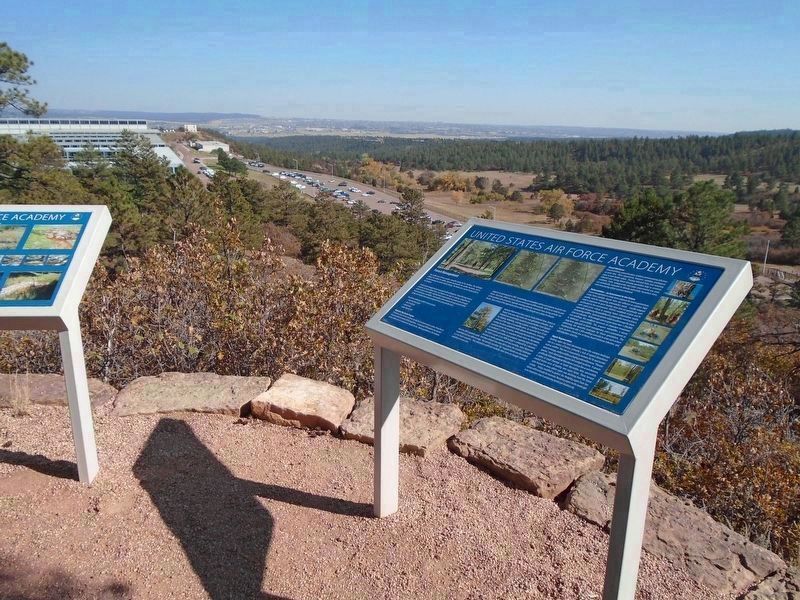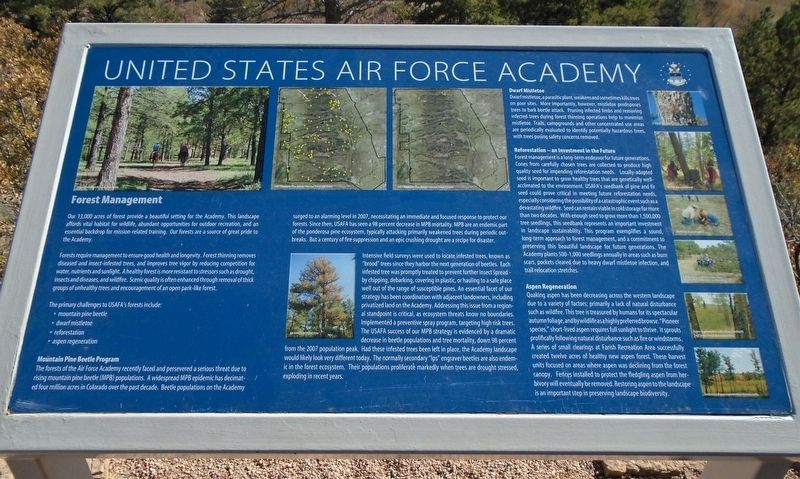Forest Management
United States Air Force Academy
Our 13,000 acres of forest provide a beautiful setting for the Academy. This landscape affords vital habitat for wildlife, abundant opportunities for outdoor recreation, and an essential backdrop for mission-related training. Our forests are a source of great pride to the Academy.
Forests require management to ensure good health and longevity. Forest thinning removes diseased and insect-infested trees, and improves tree vigor by reducing competition for water, nutrients and sunlight. A healthy forest is more resistant to stressors such as drought, insects and diseases, and wildlife. Scenic quality is often enhanced through removal of thick groups of unhealthy trees and encouragement of an open park-like forest.
The primary challenges to USAFA's forests include:
• mountain pine beetle
• dwarf mistletoe
• reforestation
• aspen regeneration
Mountain Pine Beetle Program
The forests of the Air Force Academy recently faced and persevered a serious threat due to rising mountain pine beetle (MPB) populations. A widespread MPB epidemic has decimated four million acres in Colorado over the past decade. Beetle populations on the Academy surged to an alarming level in 2007, necessitating an immediate and focused response to protect our forests. Since then, USAFA has seen a 98 percent decrease
Intensive field surveys were used to locate infested trees, known as "brood" trees since they harbor the next generation of beetles. Each infested tree was promptly treated to prevent further insect spread-by chipping, debarking, covering in plastic, or hauling to a safe place well out of the range of susceptible pines. An essential facet of our strategy has been coordination with adjacent landowners, including privatized land on the Academy. Addressing this issue from a regional standpoint is critical, as ecosystem threats know no boundaries. [USAFA] Implemented a preventive spray program, targeting high risk trees. The USAFA success of our MPB strategy is evidenced by a dramatic decrease in beetle populations and tree mortality, down 98 percent from the 2007 population peak. Had these infested trees been left in place, the Academy landscape would likely look very different today. The normally secondary "lps" engraver beetles are also endemic in the forest ecosystem. Their populations proliferate markedly when trees are drought stressed, exploding in recent years.
Dwarf Mistletoe
Dwarf mistletoe, a parasitic plant, weakens and

"Forestry program supports military, environmental missions"
Air Force Civil Engineer Center website entry
Click for more information.
Reforestation - an Investment in the Future
Forest management is a long-term endeavor for future generations. Cones from carefully chosen trees are collected to produce high quality seed for impending reforestation needs. Locally-adapted seed is important to grow healthy trees that are genetically well-acclimated to the environment. USAFA's seedbank of pine and fir seed could prove critical in meeting future reforestation needs, especially considering the possibility of a catastrophic event such as a devastating wildfire. Seed can remain viable in cold storage for more than two decades. With enough seed to grow more than 1,500,000 tree seedlings, this seedbank represents an important investment in landscape sustainability. This program exemplifies a sound, long-term approach to forest management, and a commitment to preserving this beautiful landscape for future generations. The Academy plants 500-1,000 seedlings annually in areas such as burn scars, pockets cleared due to heavy
Aspen Regeneration
Quaking aspen has been decreasing across the western landscape due to a variety of factors; primarily a lack of natural disturbance such as wildlife. This tree is treasured by humans for its spectacular autumn foliage, and by wildlife as a highly preferred browse. "Pioneer species," short-lived aspen requires full sunlight to thrive. It sprouts prolifically following natural disturbance such as fire or windstorms. A series of small clearing at Farish Recreation Area successfully created twelve acres of healthy new aspen forest. These harvest units focused on areas where aspen was declining for the forest canopy. Fences installed to protect the fledgling aspen from herbivory will eventually be removed. Restoring aspen to the landscape is an important step in preserving landscape biodiversity.
Erected by United States Air Force Academy.
Topics. This historical marker is listed in these topic lists: Disasters • Environment • Horticulture & Forestry • Science & Medicine. A significant historical year for this entry is 2007.
Location. 39° 0.399′ N, 104° 53.636′ W. Marker is in United States Air Force Academy, Colorado, in El Paso County. Marker is along the walking path from the Visitor Center to the Chapel. Touch for map. Marker is in this post office area: USAF Academy CO 80840, United States of America. Touch for directions.
Other nearby markers. At least 8 other markers are within 3 miles of this marker, measured as the crow flies. Landscape Fire Ecology (here, next to this marker); Veterans Memorial (a few steps from this marker); Scrub (Gambel's) Oak (within shouting distance of this marker); Before the Academy (within shouting distance of this marker); An Ancient Geologic Past (within shouting distance of this marker); Abert's Squirrel (within shouting distance of this marker); Fuel Hazard Mitigation (about 400 feet away, measured in a direct line); Memorial Pavilion Roll Call Record Locator Room (approx. 2.1 miles away). Touch for a list and map of all markers in United States Air Force Academy.
More about this marker. Visitors must have an unexpired official photo ID to present to security to access the USAF Academy grounds.
Also see . . . USAFA Natural Resource Management. iSportsman entry (Submitted on October 19, 2020, by William Fischer, Jr. of Scranton, Pennsylvania.)
Credits. This page was last revised on July 19, 2021. It was originally submitted on October 19, 2020, by William Fischer, Jr. of Scranton, Pennsylvania. This page has been viewed 214 times since then and 30 times this year. Photos: 1, 2. submitted on October 19, 2020, by William Fischer, Jr. of Scranton, Pennsylvania.
